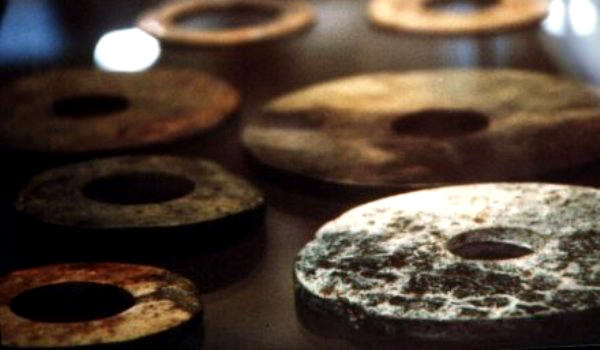Stellar Disks Bayan-Kara-Ula, China-Tibet
From series “Most Curious Artifacts of Extraterrestrial Origin”
On the border between China and Tibet is the hardly accessible mountain district called Bayan-Kara-Ula, which began to attract the first researchers in the early 20th century. The work of the scientists was not in vain - in 1937 a complex of tiny caves in the mountain massif was discovered whose structure resembled the honeycomb of the beehive. The strange caves were not empty, they kept the skeletons of the modern science unknown beings.
On the disk surfaces one can see the regular traces of the unknown symbols, the deciphering of which became the main task for thousands of scientists. According to archaeologists, the age of unusual discs is more than 14,000 years. You have found a disc in each of the 716 caves, and each disk has the unique inscriptions. Some scientists suspect that each disc contains the biography of the deceased being whose skeleton was buried in the cave. On the earth, there is no longer a find similar to the Star Discs.  Next - Narada Findings
Next - Narada Findings
Stellar Disks Bayan-Kara-Ula - interactive map
Nearest unique sightseeing spots to visit

287 km - Jiuzhaigou Valley
The amazing Jiuzhaigou Valley is located in Sichuan province. This is a national reserve of fabulous beauty. It is considered one of the most valuable in the world. The area of the valley is about 720 square kilometers. Local residents began to highlight the importance …
From the series 'The most interesting UNESCO sites in China'
The amazing Jiuzhaigou Valley is located in Sichuan province. This is a national reserve of fabulous beauty. It is considered one of the most valuable in the world. The area of the valley is about 720 square kilometers. Local residents began to highlight the importance …

353 km - Laxiwa Dam
In China, on the territory of Kingai province is Lasiva Dam, whose height is 250 meters. The huge dam on the Yellow River was built for the generation of electric power. The hydroelectric power plant was relatively recently commissioned in 2009. With a view to the fact …
From the series 'The Greatest Dams in the World'
In China, on the territory of Kingai province is Lasiva Dam, whose height is 250 meters. The huge dam on the Yellow River was built for the generation of electric power. The hydroelectric power plant was relatively recently commissioned in 2009. With a view to the fact …

381 km - Bangda Airport
Among the dangerous airports in the world you have to mention Bangda Airport, which is located in the territory of the Chamdo district in China. It is the highest airport in the world and was built at the height of 4 334 meters above sea level. The airport offers only …
From the series 'The Most Dangerous Runways in the World'
Among the dangerous airports in the world you have to mention Bangda Airport, which is located in the territory of the Chamdo district in China. It is the highest airport in the world and was built at the height of 4 334 meters above sea level. The airport offers only …

506 km - Five Flower Lake
One of the main natural attractions of China is Jiuzhaigou Nature Reserve featuring the incredibly beautiful and mysterious Five Flower Lake. One of its main characteristics is explained by the name of the lake. Its water periodically changes colors and can be yellow, …
From the series 'Fabulous Nooks of the World with Striking Colorful Shades'
One of the main natural attractions of China is Jiuzhaigou Nature Reserve featuring the incredibly beautiful and mysterious Five Flower Lake. One of its main characteristics is explained by the name of the lake. Its water periodically changes colors and can be yellow, …

508 km - Huanglong Reserve
The Huanglong Nature Reserve will impress fans of natural attractions. Its name can be translated literally as "Yellow Dragon". The main feature of this natural area is the variety of travertine terraces. They were formed from limestone tuff. These terraces cascade …
From the series 'The most interesting UNESCO sites in China'
The Huanglong Nature Reserve will impress fans of natural attractions. Its name can be translated literally as "Yellow Dragon". The main feature of this natural area is the variety of travertine terraces. They were formed from limestone tuff. These terraces cascade …

518 km - Jiuzhaigou National Park
The ideal place to explore the culture of China is the Jiuzhaigou National Park. Its name can be translated from Chinese as The Valley of the Nine Villages. This reserve is located in the north of Sichuan. It became known to the whole world for its amazing colored …
From the series 'The Most Cozy Towns Full of Zen'
The ideal place to explore the culture of China is the Jiuzhaigou National Park. Its name can be translated from Chinese as The Valley of the Nine Villages. This reserve is located in the north of Sichuan. It became known to the whole world for its amazing colored …
OrangeSmile.com - online travel reservation expert providing reliable car rental and hotel booking services. We feature more than 25.000 destinations with 12.000 rental offices and 200.000 hotels worldwide.
Secure Server




OrangeSmile B.V. - Hotel Booking Worldwide
Head office: Weegschaalstraat 3
Eindhoven,
5632 CW
Netherlands
+31 40 40 150 44
Copyright © 2002 -
OrangeSmile Tours B.V. | OrangeSmile.com | Under the direction and management of IVRA Holding B.V. - Registered at Kamer van Koophandel (KvK), The Netherlands No. 17237018













